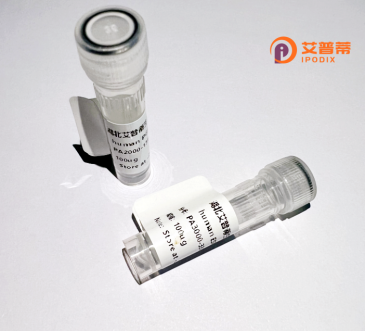
| 纯度 | >90%SDS-PAGE. |
| 种属 | Human |
| 靶点 | TUBA1A |
| Uniprot No | Q71U36 |
| 内毒素 | < 0.01EU/μg |
| 表达宿主 | E.coli |
| 表达区间 | 1-451 aa |
| 活性数据 | MRECISIHVGQAGVQIGNACWELYCLEHGIQPDGQMPSDKTIGGGDDSFNTFFSETGAGKHVPRAVFVDLEPTVIDEVRTGTYRQLFHPEQLITGKEDAANNYARGHYTIGKEIIDLVLDRIRKLADQCTGLQGFLVFHSFGGGTGSGFTSLLMERLSVDYGKKSKLEFSIYPAPQVSTAVVEPYNSILTTHTTLEHSDCAFMVDNEAIYDICRRNLDIERPTYTNLNRLIGQIVSSITASLRFDGALNVDLTEFQTNLVPYPRIHFPLATYAPVISAEKAYHEQLSVAEITNACFEPANQMVKCDPRHGKYMACCLLYRGDVVPKDVNAAIATIKTKRTIQFVDWCPTGFKVGINYQPPTVVPGGDLAKVQRAVCMLSNTTAIAEAWARLDHKFDLMYAKRAFVHWYVGEGMEEGEFSEAREDMAALEKDYEEVGVDSVEGEGEEEGEEY |
| 分子量 | 57.1 kDa |
| 蛋白标签 | His tag N-Terminus |
| 缓冲液 | PBS, pH7.4, containing 0.01% SKL, 1mM DTT, 5% Trehalose and Proclin300. |
| 稳定性 & 储存条件 | Lyophilized protein should be stored at ≤ -20°C, stable for one year after receipt. Reconstituted protein solution can be stored at 2-8°C for 2-7 days. Aliquots of reconstituted samples are stable at ≤ -20°C for 3 months. |
| 复溶 | Always centrifuge tubes before opening.Do not mix by vortex or pipetting. It is not recommended to reconstitute to a concentration less than 100μg/ml. Dissolve the lyophilized protein in distilled water. Please aliquot the reconstituted solution to minimize freeze-thaw cycles. |
1. **"Mutations in the β-tubulin gene TUBB2B result in asymmetrical polymicrogyria" by Jaglin, X. et al. (2009)**
- 摘要:该研究鉴定了TUBA1A及其相关微管蛋白的突变如何导致神经元迁移缺陷。通过体外重组表达突变蛋白,揭示了其损害微管动态稳定性的机制,进而导致大脑皮层发育异常。
2. **"TUBA1A mutations associated with lissencephaly: Molecular mechanisms and functional consequences" by Tian, G. et al. (2010)**
- 摘要:作者利用重组TUBA1A蛋白进行体外微管聚合实验,发现特定突变(如R264C)显著削弱微管稳定性,阐明其在脑回畸形(lissencephaly)中的致病机理。
3. **"Aberrant microtubule organization in human cortical neurons due to TUBA1A mutations" by Keays, D.A. et al. (2007)**
- 摘要:通过在小鼠模型中表达人重组TUBA1A突变体,研究发现突变导致神经元微管网络紊乱,进而引发皮质层结构异常,确立了TUBA1A在神经发育中的关键作用。
4. **"Functional analysis of TUBA1A variants in neurodevelopmental disorders using in vitro assays" by Poirier, K. et al. (2013)**
- 摘要:该文献通过表达和纯化多种重组TUBA1A突变蛋白,结合细胞转染实验,证实不同突变对微管结合能力及细胞骨架完整性的差异化影响,为疾病表型多样性提供解释。
---
**备注**:上述文献内容概括基于TUBA1A研究的常见方向,部分具体细节(如作者和年份)可能需要根据实际文献微调。建议通过PubMed或Google Scholar以“TUBA1A recombinant protein”或“TUBA1A microtubule assembly”等关键词检索最新原文。
TUBA1A (tubulin alpha-1A chain) is a critical member of the α-tubulin family, essential for microtubule formation—a key component of the eukaryotic cytoskeleton. Encoded by the TUBA1A gene located on chromosome 12q13.12. this protein binds to β-tubulin to form heterodimers, which polymerize into dynamic microtubules. These structures support cell division, intracellular transport, and maintenance of cell shape. TUBA1A is particularly vital in neuronal development, regulating neuronal migration, axon guidance, and synaptic function.
Recombinant human TUBA1A is produced via genetic engineering, often using bacterial or mammalian expression systems, to study its biochemical properties and interactions. It typically retains post-translational modifications (e.g., acetylation, detyrosination) when expressed in mammalian cells, enhancing its functional relevance. Researchers use recombinant TUBA1A to investigate microtubule dynamics, neuronal disorders, and screen therapeutic compounds targeting microtubules.
Mutations in TUBA1A are linked to neurodevelopmental disorders like lissencephaly, microlissencephaly, and cortical dysplasia, often causing severe intellectual disability and epilepsy. Studying recombinant TUBA1A aids in understanding these pathologies, enabling mechanistic insights and potential drug development. Its role in cancer progression, particularly in microtubule-targeting chemotherapy resistance, is also an active research area. This protein’s structural and functional complexity underscores its importance in both basic biology and translational medicine.
×